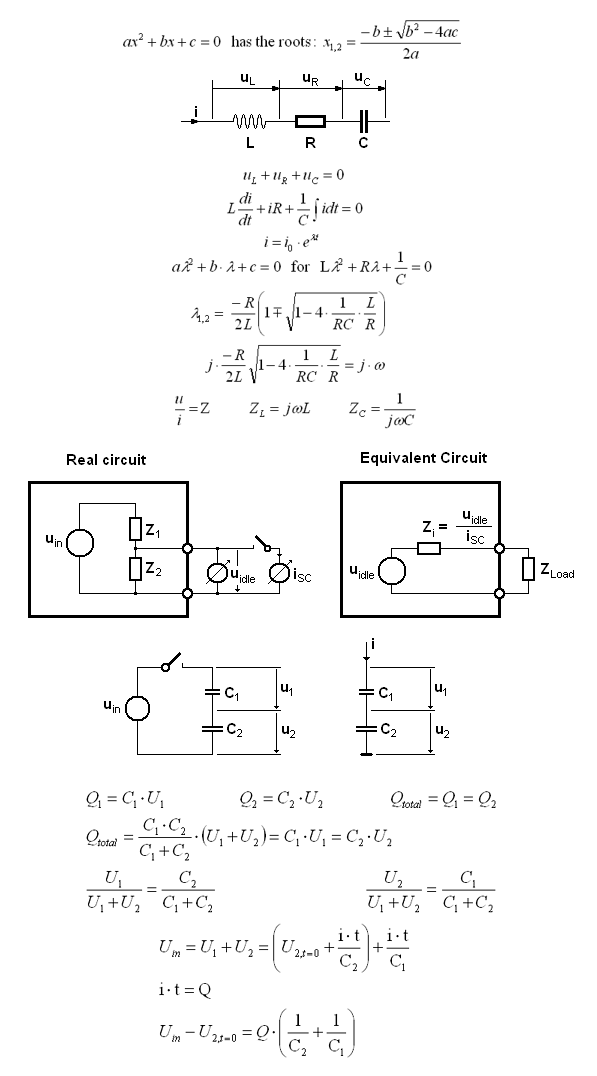 |
||||||||
|
|
|
|
||||||

|  |
|||||||||||||||||||||||||||||||||||||||||||
Diodepump |
 |
Diodenpumpe |
|
Introduction into mathematics needed for calculus of the diodepump The diode-pump is pretended an insignificant-simple electronic circuit, which only consists of 5 components, but the complete description, what it really is in all details, is a long story. It got a big meaning in the 1960's in the radiation-physics, where radioactive radiation, coming as particles into a Geiger-counter, causing there electronic metering-pulses, which could be used, among others, to measure thickness of material, because intensity of through-coming radiation was, due to the properties of penetrating radiation, an exponential function of the thickness. Logarithmizing with the voltage-current-characteristic of diodes implicated a high temperature-dependance and buildups where made for temperature-stabilising, but problems were great and the diode-pump had no temperature-dependance. The diode-pump works similar as a water- or air-pump, pumping a medium into a tank, which has a hole at the bottom, where the medium is running out again. The faster you pump, the higher the filling-level in the tank. The both diodes of the diode-pump work similar as the valves of an air-pump, they are only pervious in one direction. The practical buildup and measurement of the diode-pump's properties delivers sufficient values for the needed frequency-response-function in dependence of the chosen components in order to get a proper dimensioning. But how can it be understood mathematically and got calculated specifications with optimizing linearity-errors and can be given exact information about the measurement-error ? |
Einführung in die nötige Mathematik zur Berechnung der Diodenpumpe Die Diodenpumpe ist ein scheinbar unbedeutend einfacher Schaltkreis, welcher nur aus 5 Bauteilen besteht, aber die komplette Beschreibung, was sie wirklich ist - in allen Details, ist eine lange Geschichte. Sie bekam eine große Bedeutung in den 1960-igern in der Strahlenphysik, wo radioaktive Strahlung, die als Teilchen in Geiger-Müller-Zähler kamen und dort Zählimpulse verursachten, die verwendet werden konnten, u.a., um Materialdicke zu messen, weil die Intensität der durchkommenden Strahlung, wegen ihrer Eigenschaften als durchdringende Strahlen, eine Exponentialfunktion der Dicke war. Logarithmierung mit der Strom-Spannungs-Characteristic von Dioden wies eine hohe Temperaturabhängigkeit auf und es wurden Aufbauten zur Temperaturstabilisierung gemacht, aber die Probleme waren groß und die Diodenpumpe hatte keine Temperatur-Abhängigkeit. Die Dioden-Pumpe arbeitet ähnlich wie eine Wasser- oder Luft-Pumpe, sie pumpt ein Medium in einen Tank, welcher ein kleines Loch an seiner Unterseite hat, wo das Medium wieder ausläuft. Je schneller man pumpt, umso höher der Füllstand im Tank. Die beiden Dioden arbeiten ähnlich wie Ventile, sie sind nur in einer Richtung durchlässig. Der praktische Aufbau und die Messung der Eigenschaften der Diodenpumpe liefert genügend Werte für die benötigte Spannungs-Frequenz-Kennlinie in Abhängigkeit der gewählten Bauteile um zu einer geeigneten Dimensionierung zu gelangen. Aber wie kann sie mathematisch verstanden und die Spezifikationen berechnet werden mit Optimierung des Linearitäts-Fehlers und wie kann exakte Information über den Messfehler gegeben werden ? |
Extra made for the beginners, all theory starts, from far off from the matter, with the quadratic equation and how their roots can be found, because in the quadratic equation is the origin, from where imaginary numbers come into the equations of electronic circuits serving there as symbols for the characteristic, physical properties of electronic components. Because the quadratic equation is the root of the differential-equation of the electric oscillation-circuit and the quadratic equation has occasionally, depending on the special values of their coefficients, imaginary numbers as roots, which occur then in the exponents of the exponential-functions of the differential-equation, what guides us to the periodic oscillations. And all this is extra done only to shed light on the notion of impedance, which is extra used to show the principle of conversion from a real-circuit to an equivalent-circuit, in order to proof, that the equivalent-circuit is justifiable to be used for all kinds of periodic and aperiodic signals. Because the equivalent-circuit is necessary to make all formulas simpler. And that is finally the completed pre-condition for starting to set up the calculus-equations for the diode-pump, which is shown on the next website. The complete disquisition on the PDF-file, you find the link to, underneath. | ||

| ||
last update For beeing able to read and print PDF-files, |
letzte Aktualisierung Um PDF-Dateien lesen und ausdrucken zu können, |